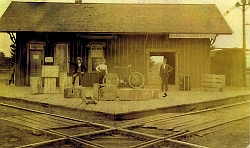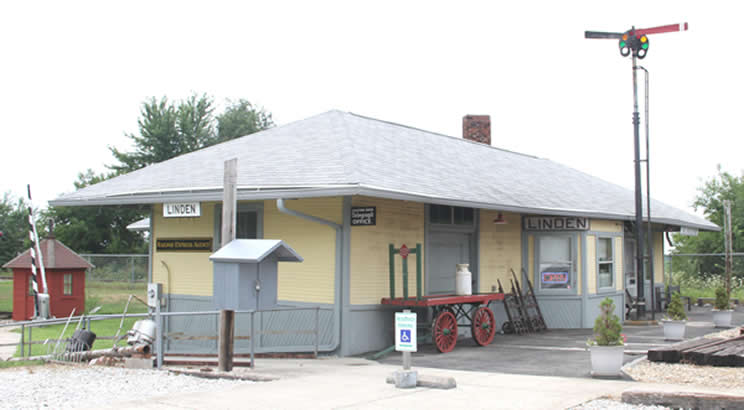History of the Linden Depot
Early railroad construction in Indiana was primarily aimed at connecting interior markets with the canal and river system already being used to transport freight to the lucrative eastern US markets. In 1850, a 300-mile long north-south railroad line was being constructed to connect the Ohio River (in Louisville, KY) with Lake Michigan (in Chicago, IL.) In November of that year, in anticipation of the advantages of the new railroad, three men from Montgomery County, Hiram Hughes, Joel Lee and William Hartman, platted the new town of Linden, located 10 miles north of the county seat of Crawfordsville. The name Linden is assumed to have come from the prevalent linden trees in the area, taking its cue from other early settlements such as Cherry Grove and Oak Grove.
The new railroad was completed in 1852, and was known as the “Chicago, Indianapolis & Louisville Railroad.” The first railroad station in Linden was located behind the Post Office on Walnut Street, one of the five 2-block long east-west streets that were originally platted. The wooden structure, with a frame of hand hewn timbers, was also completed in 1852 to serve the new “CI&L Railroad.”
From 1874 to 1882, a 450-mile narrow-gauge railroad known as the “Clover Leaf,” was constructed from Toledo, OH to St. Louis, MO. It passed through Linden, IN, which was the halfway point between the two cities. It crossed the “CI&L” about a half mile north of the Linden Depot. By 1882, “CI&L” had started using the name “Monon” on its company maps and timetables, as well as on its rolling stock, so in 1882 it was correct to say the “Clover Leaf” crossed the “Monon” in Linden. The word “Monon” was from the Potawatomi Indian words that sounded like “metamonong” or “monong” which meant “tote” or “carry”, or “swift running”.
Unlike most of the Midwestern railroads built after the 1830’s which connected Eastern cities with the newly settled west, this north-south railroad line was considered a larger business risk; over time, though, it became more and more important to the passengers and shippers looking for connections to existing east-west lines. As train lines increased in length and capacity, many improvements began to be made to better take advantage of this new business of train travel. One of the most important was the standardization of track gauge. Many train lines, such as the “Monon,” were using Standard Gauge, meaning the distance between the track rails was 143.5 cm or 56.5 in. Others, including the “Clover Leaf,” were using Narrow Gauge. Technically, Narrow Gauge track is any spacing less than Standard Gauge, but in the US, that distance is usually 36 in. If two train lines were trying to connect, and one was Standard Gauge, and the other was Narrow Gauge, the freight or passengers had to be transferred from one train to another, as neither train could ride on the other’s rails. By standardizing all railroads to Standard Gauge, trains could ride on each other’s rails; this was an obvious advantage, especially with regards to shipping or travel time.
In 1887, the “Clover Leaf” began widening its rail corridor to “Standard” gauge. By 1889, the widening of the Frankfort to St. Louis section (through Linden) had been completed. Now the “Clover Leaf” was fully standardized and connected the entire 450 miles from Toledo, Ohio to East St. Louis, Missouri. In 1895, the Linden Depot was moved to the “Monon” / “Clover Leaf” Crossing and placed diagonally at that intersection.

The Linden Depot quickly became a hotbed of freight and passenger transfer service. On January 9, 1907, the Depot was consumed by a fire that was discovered around 7 pm that evening. Two “Clover Leaf” cabooses were quickly set up, one to serve as a temporary waiting station, and the other for working quarters. A contract agreement between “CI&L” (or the “Monon”) and the “Clover Leaf” was entered into October 21, 1907 for construction of new joint station facilities for passengers and for freight at the crossing in Linden. The freight station, located at the south-west corner of the crossing, was completed in 1908. The L-shaped passenger station, located at the southeast corner of the crossing, was completed in 1909; the passenger station known as “The Depot” still stands today.

In the 1920’s, the growth of the new automotive industry began to have an effect on railroads. People, especially wealthy people, began to own automobiles, and were quite proud to use them for travel. Trucks began to be used to deliver goods. Thus, cars and trucks began to take traffic away from the railroads; this caused many of the smaller railroad lines to be bought out by the larger, more profitable lines.
On December 28, 1922, the “Nickel Plate Railroad” purchased the “Clover Leaf.” The term “Nickel Plate” had first been used in 1881 by the editor of the Norwalk, Ohio Chronicle who used the term to describe the track of the railroad between New York and St. Louis. It was used to indicate the glittering prospects of such a railroad line, and the substantial financial backing received for its construction. The term was made up from the “NY” of New York, the “C” from Chicago and the “L” from St. Louis: the “NyCL-Plated Railroad.” In 1922, it was finally correct to say that the “Nickel Plate” crossed the “Monon” in Linden, Indiana.
The “Nickel Plate Railroad” made major improvements to its railway: they cut fuel consumption in half, while doubling the average speeds and total freight tonnage throughout the entire line. In 1934, the first 15 of the legendary 2-8-4 Berkshire Locomotives were purchased and became well-known throughout “Nickel Plate” country. In 1935, the “Chesapeake and Ohio Railway” gained control of the “Nickel Plate.” The “Nickel Plate” was at its best at this time with its upgraded physical plant and locomotive fleet, and even though it only controlled 2000 miles of track, served many important midwest cities. Then in the 1930’s, there was the Great Depression. This nearly destroyed railroad companies all across the country as moving freight by rail dropped precipitously. Passenger travel was at a prohibitive cost to all but the wealthiest travelers. Railroads started looking desperately to find ways to lower operating costs.
By the 1940s, diesel engines began to replace steam locomotives. Why? Because they were cheaper to operate. But during World War II, the “Nickel Plate” ordered 55 more of the Berkshires. These were extremely capable locomotives that could be used for hauling heavy freight as well as for speedy passenger service. Trains moved many troops and supplies across the country during the war. In 1942, the “Monon” received its first diesel engine. It was exhibited behind the Linden Carnegie Library as the “Train of Tomorrow.”
In 1946, John W. Barringer III, the President of the “Monon Railroad” purchased new Diesel F-3s for passenger and main line freight service. In 1948, the last steam engine ran its regular run and the “Monon” became the first “Class A” railroad to be fully dieselized. It continued to operate entirely within Indiana, however; as a result of a conscious decision by its Board of Directors, the “Monon” never went any further south than its connections in Louisville, and never took advantage of the connections to the coal mines of Kentucky. Nor did it ever expand beyond its track rights of way into Chicago or other points north.
The “Monon” tracks formed a large “X” through Indiana, which cross in Monon, Indiana. Leg 1 went from Dearborn Station in Chicago to Union Station in Indianapolis. Leg 2 went from Michigan City to Louisville, Kentucky. The Monon to Michigan City leg was considered a branch line, as was the Monon to Indianapolis leg and the section that traveled through Orleans through West Baden Resort Hotel and to French Lick Springs Hotel.
In 1947, the “Nickel Plate” finally ordered 11 bright blue diesel-electric locomotives named the “Bluebirds.” This marked the first time since 1900 that any ‘Nickel Plate” locomotives were painted any color other than black. Steam Engines were completely retired from the “Nickel Plate” line in 1951. During this same year, the “Chesapeake and Ohio Railway” sold its shares of and ended its control of the “Nickel Plate Railroad.”
In 1957, passenger service on the “Nickel Plate Railroad” was discontinued. This marked the beginning of the end of the Linden Depot. The Freight House at the Linden Depot was removed in 1960 when truck transportation replaced train deliveries. Due to the continuing financial decline of American railroads in general, the “Nickel Plate” merged into the more profitable “Norfolk & Western Railroad” along with the “Wabash Railroad” and several smaller railroad lines, on October 16, 1964. Then in 1982, “Norfolk & Western” which was profitable, merged with the “Southern Railway”, also a profitable carrier, and formed “Norfolk Southern Corporation.”
In 1964, passenger service to Linden on the “Monon Railroad” was discontinued. The last mail delivered to Linden by train was in 1966. This spelled the end of the Linden Depot. While the Depot remained open until the early 1970s, only a few freight trains stopped there, and by 1972, the Depot was closed.
The Depot remained closed until the 1980s when a group of people from the town of Linden, Indiana, and from the surrounding Madison Township of Montgomery County, formed The Linden-Madison Township Historical Society, a not-for-profit group with the purpose of restoring the historic 1909-built Linden Depot and converting it into a railroad museum. Articles of Incorporation were filed and accepted May 5, 1986. That same year, the “Norfolk Southern Railroad” agreed to donate the depot to the Society, but wanted to require the group to move the depot away from the railroad’s right-of-way. In 1988, “Norfolk Southern” and “CSX” Railroads agreed to allow the society to purchase the land upon which the depot stood. In 1989, the two railroads agreed to allow the depot to remain in its original location so long as a protective fence was erected between the depot and the current “CSX” track. In 1990, the depot was placed on the National Register of Historic Places.

In April of 1993, after the expenditure of many hours and dollars in its restoration effort, the depot opened its doors to the public as a railroad museum. That same year, a model railroad club was formed to construct the HO-gauge model train layout in the “Monon” baggage room. In 1998, Martin Levin designed and constructed two very elaborate N-gauge layouts and donated them to the museum. Gary Vierk became President in 2007, and has worked tirelessly to increase the Museum’s collection of railroad memorabilia and to raise awareness of this historic site. On April 13, 2013, the museum celebrated its 20th anniversary
.